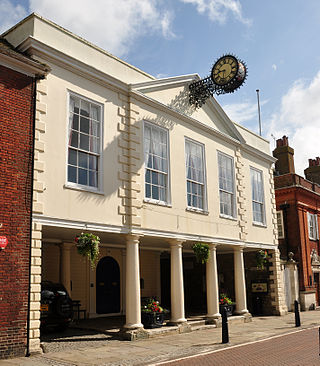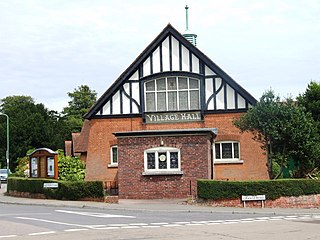
Folkestone is a port town on the English Channel, in Kent, south-east England. The town lies on the southern edge of the North Downs at a valley between two cliffs. It was an important harbour and shipping port for most of the 19th and 20th centuries.

The Romney, Hythe and Dymchurch Railway (RH&DR) is a 15 in gauge light railway in Kent, England, operating steam and internal combustion locomotives. The 13+1⁄2-mile (21.7 km) line runs from the Cinque Port of Hythe via Dymchurch, St. Mary's Bay, New Romney and Romney Sands to Dungeness, close to the Dungeness nuclear power stations and Dungeness Lighthouse.

Romney Marsh is a sparsely populated wetland area in the counties of Kent and East Sussex in the south-east of England. It covers about 100 square miles (260 km2). The Marsh has been in use for centuries, though its inhabitants commonly suffered from malaria until the 18th century. Due to its location, geography and isolation, it was a smuggler's paradise between the 1600s and 1800s. The area has long been used for sheep pasture: Romney Marsh sheep are considered one of the most successful and important sheep breeds. Criss-crossed with numerous waterways, and with some areas lying below sea level, the Marsh has over time sustained a gradual level of reclamation, both through natural causes and by human intervention.
Hythe, from Anglo-Saxon hȳð, may refer to a landing-place, port or haven, either as an element in a toponym, such as Rotherhithe in London, or to:

Hythe is a market town and civil parish on the edge of Romney Marsh, in the district of Folkestone and Hythe in Kent, England. The word Hythe or Hithe is an Old English word meaning haven or landing place.

New Romney is a market town in Kent, England, on the edge of Romney Marsh, an area of flat, rich agricultural land reclaimed from the sea after the harbour began to silt up. New Romney, one of the original Cinque Ports, was once a sea port, with the harbour adjacent to the church, but is now more than a mile from the sea. A mooring ring can still be seen in front of the church. It is the headquarters of the Romney, Hythe and Dymchurch Railway.

Folkestone and Hythe is a local government district in Kent, England, in the south-east of the county. Its council is based in the town of Folkestone. The authority was renamed from Shepway in April 2018, and therefore has the same name as the Folkestone and Hythe parliamentary constituency, although a somewhat narrower area is covered by the district.

Lympne, formerly also Lymne, is a village on the former shallow-gradient sea cliffs above the expansive agricultural plain of Romney Marsh in Kent. The settlement forms an L shape stretching from Port Lympne Zoo via Lympne Castle facing Lympne Industrial Park then via the main settlement to Newingreen in the north, centred 11 km (7 mi) west of Folkestone, 2.3 mi (3.7 km) west of Hythe and 13 km (8.1 mi) ESE of Ashford.

Etchinghill is a village in Kent, England, about 5 km north of Hythe, and 1 km north of the Channel Tunnel terminal at Cheriton, near Folkestone. It is in the civil parish of Lyminge.

Halberton is a village and civil parish in Devon, England. It is situated between the historic market towns of Tiverton and Cullompton. The Grand Western Canal runs around to the north and west of the village.

Elham is a village and civil parish in East Kent situated approximately 9 miles (14 km) south of Canterbury and 5 miles (8 km) north west of Folkestone in the Elham Valley. At the 2011 Census the population included the hamlet of Ottinge and village of Wingmore.

Hamstreet is a village in Kent, in South East England.

Newington is a village and civil parish in the English county of Kent located 1 mile (1.6 km) north-west of Folkestone. It gives its name to Newington Parish Council, which has five councillors, and includes the hamlets of Arpinge and Beachborough. The village lies to the north of the M20 motorway and the A20 road; the Channel Tunnel complex is nearby.

Saltwood is a village and civil parish in the Folkestone and Hythe District of Kent, England. Within the parish are the small hamlets of Pedlinge and Sandling.

Botolphs, formerly known as Annington, is a tiny village and former civil parish, now in the parish of Bramber, in the Horsham District of West Sussex, England. It is in the Adur Valley 1.5 miles (2.4 km) southeast of Steyning on the road between Steyning and Coombes. Botolphs lies on the South Downs Way long-distance footpath. In 1931 the parish had a population of 64. On 1 April 1933 the parish was abolished and merged with Bramber.

East Calder is a village located in West Lothian, Scotland, about a mile east of Mid Calder and a mile west of Wilkieston. It forms part of 'the Calders, three small neighbouring communities situated west of Edinburgh and south of the "New Town" of Livingston.
Prince of Wales Halt railway station was a short-lived station on the Romney, Hythe and Dymchurch Railway in Kent, England.

Botolphs Bridge Halt railway station was a little-used station on the Romney, Hythe and Dymchurch Railway in Kent, England.

Burmarsh is a village and civil parish in the Folkestone and Hythe District of Kent, England. The village is located three miles (4.8 km) west of Hythe on the Romney Marsh. The Burmarsh Road connects the village to the once fully operating Burmarsh Road train station. The closest major settlement is Folkestone which is a minimum of 9.5 mile car journey.
Palmarsh is a community in Folkestone and Hythe district, in the County of Kent, England. In origin it was a hamlet on the edge of the Romney Marsh, but modern development to the west of Hythe in a corridor along the A259 coastal road, has led to the joining together of the ancient town and cinque port of Hythe and the rural hamlet of Palmarsh in a single conurbation.





















